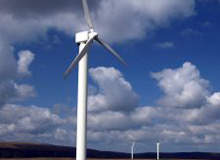
A recent study carried out by Friends of the Earth studied 44 reference sources to answer the most frequent objections raised to wind power.
One of the 'myths' – and a criticism that periodically surfaces – is that wind supplies are unsuitable because they are intermittent. The wind doesn't always blow, just as the sun doesn't always shine. That means, detractors say, these sources cannot power the grid on their own, and the required backup power sources push up costs so far as to make them uneconomic.
INTERMITTENT SUPPLY
Wind is, indeed, intermittent – as are all power sources. Transmission systems already need significant back-up to cope with the unexpected, instantaneous outages and loss of power from large power stations. Coal, gas and nuclear plants must be shut down, often at short notice and sometimes for long periods.
This sudden drop is much more difficult to deal with than the variability of wind power, as they operate on a much larger scale. Transmission systems also need back-up to cover surges in demand at meal times and during TV ad breaks, lightning strikes on high-voltage power lines, and transformer failures.
At present levels, variations in the output from wind farms are barely noticeable over and above the normal fluctuations in supply and demand. And the cost increases to cover the back-up required for wind are relatively small. The FoE quotes a review of studies carried out by the Sustainable Development Commission, which estimated that the additional cost of providing 20% of electricity from wind energy by 2020 would be just 0.17p/kWh.
NOT A 'LEVEL PLAYING FIELD'
Here as elsewhere, renewables are often subject to criticism while fossil fuels are given a free pass. When comparing them, costings routinely ignore fuel (let alone the likely future fossil fuel price rises), and the external costs like environmental and health damage that would, for example, double the 'real' costs of coal and oil.
Nuclear costs should similarly include the future commitment to costs of protecting a whole vulnerable supply chain, and the full costs of site decommissioning and nuclear waste disposal. Instead, nuclear and fossil fuels are now given all manner of subsidies.
Wind power is a good match for demand in the northern hemisphere, since it delivers most electricity during winter – so in periods of high demand. In the UK wind is easily the largest renewable energy resource. When it is not blowing in one region, it is blowing in another.
Of course, it is only part of the solution. It cannot meet all demand, but it can make a significant contribution, particularly when backed by other renewable sources.
Renewables and efficiency measures are complementary – we need as many solutions as possible. We need a variety of renewable energy sources, with international power grids feeding solar power northwards and feeding wind/wave power southwards. And we need to invest in public transport and replacing/upgrading the most wasteful equipment in industry/housing.
The myth that wind power is ineffective because it is intermittent is similar to the other myths covered by the FoE: that it is unsightly, unpopular, noisy, taking over the countryside and damaging wildlife. The objections are either untrue, or if the same criteria were applied to fossil fuel plants and road traffic, we would be closing down our whole infrastructure.



